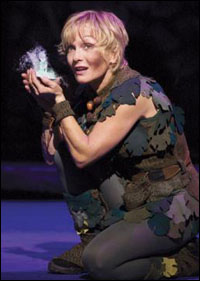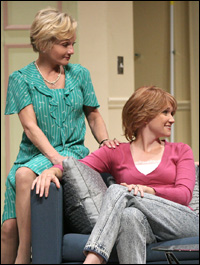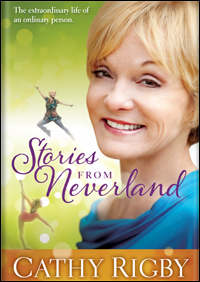
*
At 58, Rigby begins rehearsals the first week in August for a high-flying comeback tour of the revival of the 1954 Broadway musical about J.M. Barrie's Boy Who Wouldn't Grow Up. The former Olympic gymnast reunites with previous creative collaborators (including director Glenn Casale and choreographer Patti Colombo) for the production that launches in late August and plays into 2012.
Its late 2011 Manhattan stop is not on Broadway — where she was Tony Award-nominated as Best Actress in a Musical in 1991 — but at the Theater at Madison Square Garden. We caught up with her in July, a few weeks before she began filming a new "American Girl" movie, which preceded her re-attaching the wires to take flight again in Peter Pan.
You're coming back.
Cathy Rigby: We're coming back! Yeah, I'm coming back. You know what? The great thing about doing Peter Pan is that it demands that I get in shape [laughs] and make sure that I'm healthy — voice in shape and all of that. Fortunately, I have been able to do a bunch of shows in between. A while back we did Steel Magnolias and Sylvia and some other shows. It's time to put the green tights back on —and I kind of missed it actually.
But there was a time when you said, "I'm going to hang the tights up for good…" Your "farewell tour" was in 2004-05.
CR: I know. I changed my mind. I thought, the last time I did it [on tour], "How can I do it at my age?" And that's the main reason you stop — because you predict what might feel like in the future. We did it regionally last summer… and after doing it last summer, I thought, "Why not?" I miss it, I love it, it's something that has brought great joy to me and hopefully to the audiences, and I've honestly never felt better. I've been working out and dancing and taking Pilates. [The farewell tour was billed as such because] I just wasn't sure where I'd be at this point. As long as I can be believable on stage and I don't have to compromise anything that I've done, we said, "Let's do it again." The great thing about Peter Pan is that there is always this kind of new generation of kids — if you wait five or six years, there's always families with new children and kids that are old enough. It just seemed like a bottom-line "why not?"
I'm a big fan of director Glenn Casale's production of Peter Pan, which you've been doing since the late '90s. You guys really expanded upon the original musical but completely honored the original, as well. Are the design elements new this year? I love scenic designer John Iacovelli's whimsical work.
CR: Yeah, he's back... He's redone the sets and some of the drops. We decided that part of the scenery will be a little more adventure-driven, so he's gone in and he's redone some of the different scenes of Neverland, and kept a lot of the same [sets]. Some are more colorful, some are just more interesting. The ship itself is a little darker than it used to be — a darker, grittier-looking ship. And we're putting some more scenic elements in Neverland itself. It was an area where I thought we needed more — the last time, we had to go a little more economically. Now we're making it a little more vibrant.
Is it the original costume designer as well?
CR: Yes, Shigeru Yaji. Most of the costumes are going to be redone, and Nana is going to be redone, just so we have a fresh, new look and new people. It deserves to have that.
| |
 |
|
| Rigby in Peter Pan |
CR: There's a lot of new construction… The sets have been rented out, and some of the hardware that we could save, we obviously did because it's much more expensive to start from scratch. But all of it has been refurbished and redone, and it has a new look to it.
But you and your production company did not store the sets with the thought that you would return to Peter Pan. You had moved on. You really were sincerely retired from this, right?
CR: No, I really was. I really did believe it at the time. How do I say this? That's sort of how my life is [laughs] — things just change. I'm one that kind of goes with the moment. I'm not explaining this very well, but I thought about it, the opportunity came up, and I thought, "Why not?" People take stock in what they like and what they want to do, and I found that I really miss it. I miss the character.
When I was in a couple of the last [touring] spots, I came out after the show and I would sign posters to raise money for a Discovery Arts, which is the charity where we go into hospitals on Thursdays and we bring costumes and coloring and face-painting for kids who can't get out of the hospital, who are very sick children. Anyway, I started meeting the audience — our audience — for Peter Pan. It was a very, very different perspective on how it touched people. People that had seen Mary Martin [in 1954 and on TV] all the way to Sandy Duncan [in 1979] to shows that I've done in the past — they were bringing this different generation of children in, and it was just really touching. I wish all performers had the opportunity to go out afterwards… We're really grateful that we get to do what we love, but we don't often really have a chance to see how it touches people and what it means to them. I started doing this and I found myself going out every day. And I just thought, "God, what an amazing opportunity to be able to have this little role that I play that affects people, that affects children, that is a memory-making moment for these families…" So I just didn't want to stop at that point because I am physically capable.
It sounds like it feeds your soul.
CR: It does feed the soul. It's better than applause. You see that you can make a difference. How frivolous or little that you think it may be, it does make people happy. It means more then. It's not just a show.
The show is really special to me in that I grew up seeing reruns of the Mary Martin TV version in the '70s. The first Broadway show that I saw was the Sandy Duncan revival.
CR: What was that, '79?
Yes, well, I saw it in the summer of 1980.
CR: Oh my gosh, I brought my son to that.
I was 15 years old, more kid than adult, and I thought it was incredibly magical. What was the first Peter Pan you saw? Was it Mary Martin on TV?
CR: It was Sandy. The very first Peter Pan I saw was not on television. I didn't see the Mary Martin version until after I saw Sandy do it, and that was in '79, and I brought my son there, who was very young at the time. When Sandy came flying out over the audience — Uh! His eyes! — there was this twinkle in his eyes, and we were sitting together and we were by ourselves, and it was like, "Wow. I will never forget this," and he is a now man with children of his own, and the story goes on.
Remind me the first time you ever did the show.
CR: I did an arena show right after I got out of gymnastics in '72. It was a time when athletes didn't really have agents and we didn't really know what we were going to do after we retired, and a gentleman from NBC Entertainment came to me and said, "How would you like to do an arena version of Peter Pan? Don't worry, you don't have to sing because it's in an arena. It's pre-recorded music and dialogue, and it's this mammoth show that covers an arena of 100,000 people, and you just basically mime the role." And I thought, "Well I can do that. I know movement." I had never sung before, never acted really, didn't know what blocking was or any of that, and that was around 1974. Anyway, I did that show for about a year-and-a-half on the road, and somebody in the cast said, "If you really like doing this" — and I did, I fell in love with doing this — "why don't you take voice classes and acting classes?" And I had taken some ballet and certainly had the physical ability to do it — to do theatre — and so I did. I studied for seven years — voice and acting — and then, years later, in 1981, auditioned for Dorothy in The Wizard of Oz and managed to get the part.
The next time I did Peter Pan was in 1986 in Long Beach, California. It was the first live [sung and acted] Peter Pan I did. I had done theatre before that, but it was the first time I had done the actual role in a regular theatre.
And you first played it on Broadway in 1990. There's this ownership, now, that you have about the role. Not because of how many times you've done it, but because you embody this character so brilliantly — because of your size and your athleticism. You really do play it as a boy like no woman has played it before.
CR: I appreciate that, thank you. I was very much a tomboy, and kind of a fighter for life, and a scruffy kid, and always climbing and jumping and daring and mischievous. I didn't play by the rules as a kid. I would find a way over and around obstacles and challenges. And Peter is very much like that, and I find that character within myself all of the time. I have to stop myself sometimes because I really can act kind of immature and hide under the table or jump up on the table [laughs], or play pranks on people, and you just become that.
There's been so many books written about it — "you need to find the inner child in your life." I think it saved my life so many times, and it definitely opened up my world. I came from a sport where you are very single-minded and adult-like, and there's a lot of responsibility, and perfection is the name of the game, and this is about letting go of all of that and playing the moment. Peter doesn't think ahead and he doesn't really plan like Wendy does, or the other characters, because he doesn't have to grow up and he doesn't feel with emotion.
When I last saw you do it — in 2004, I think — your performance really did seem spontaneous, of the moment. I got the feeling that you didn't plan how many handstands you might do in the Darling nursery, for example.
CR: Exactly. Or he could just ignore you or laugh at you... I've had kids that come up to me after the show and go, "Are you Peter Pan?" And, I go, "Yeah."... "You were really good. I really liked it, but as I get up close, I see you have wrinkles." I mean, they don't care what they say! [Laughs.] They're just direct in the moment and honest and sometimes confrontational and sometimes as sweet as they can be, but usually always really honest with what they're feeling in the moment.
| |
 |
|
| Cathy Rigby and Amy Sloan in Steel Magnolias at La Mirada Theatre. | ||
| photo by Michael Lamont |
CR: Well, the prep is... I teach at our conservatory, the McCoy Rigby Conservatory of the Arts, so I have access to ballet and exercise equipment. And I got a trainer about a year ago, actually, knowing that this was coming up. It's based on Pilates, because I found that that's the best thing that will work for me: you are a little more careful of exactness and preciseness in your exercise rather than just going out and running marathons and ballistically jumping up and down. I found that, for me and the dance that I do in Peter Pan, especially, I need to be flexible — I need to be strong, I need my range of motion to be there, and so, Pilates, mostly.
When women, particularly, reach a certain age, your bones are different. Did you get a calcium check before embarking on this? Do you have to think about these things?
CR: I did all of that. I actually did all of that, and in fact, my doctor said, "Stop taking so much calcium and take your Vitamin D and you'll be fine." You know, I don't have any — I'm knocking on wood at the moment — issues with anything bad. He said my bones were 20 years younger [than my age], and I have to think that that's because of the training that I've done in the past. Because of the gymnastic background — when you know how to fall, and you know how to jump, and when something is at all tweaked or hurting — you are just very careful about how you do things. I am very careful about how I warm up, how I stretch, that I'm exact on landing. Other than that, I just go for it. But I use weights, I do the Pilates, a personal trainer that just kicks my rear end, so...
You're working on a book, and I hear you touch on overcoming negative parts of your past.
CR: It's called "Stories From Neverland." I've really had a very eclectic, strange career path — from gymnastics, to ABC Sports, to theatre, to running a conservatory, to children… Lots of challenges and obstacles along the way. My dad was an alcoholic, my mother had polio. My mother was a gymnast and I never knew it until I made my first Olympic team. And I never believed that she had challenges in her life because she was just "mom." And yet she walked with crutches and she was in a wheelchair, but that was just mom. And mom built fences, and mom mowed the lawn, and mom worked and raised five children. It might go along with why I believe that we all had challenges, but there was a way to get around them and through them.
| |
 |
|
| The cover of Rigby's forthcoming book. |
And, was your dad's alcoholism a negative shadow in your life?
CR: Very. Very, very much so. Very much. My dad had a degree in physics and math and was an aeronautical engineer, and didn't work my entire childhood. And, so my mom who has got these challenges, lived and raised five kids. My dad, he's been sober for many, many years, and we've all talked about this, and he's doing great, and my mom is 84, almost 85, and my dad is 85. Their lives are great now, but the whole growing up process was a big challenge. Do you think that being a dancer and being an athlete and being used to physical pain makes you deal with emotional pain better?
CR: I think so. Absolutely. It certainly makes you tougher. And I think when you grow up in chaos, it makes you tougher, and sometimes that's the very thing that drives you. When you become an obsessive-compulsive person who needs to please, it can work for you to make you basically work harder than everybody else and get through obstacles because you're used to obstacles. [Laughs.] But it can also play havoc in your life later because it works both ways: The very thing that makes you good or great at what you do is the same thing that can hurt you in life.
I'm incredibly mindful of what you have said in the past, which is that Peter Pan is introducing kids to the theatre for the first time. And it's a tale that plays by musical theatre rules. Songs are rich in story and character. It's not just a bunch of pop songs thrown into an experience, or driven strictly by special effects.
CR: I think as producers we become afraid of trusting the story. There are so many amazing shows out there with beautiful sets and costumes, and millions and millions of dollars, but theatre is also about the story. I don't want this to ever happen with Peter Pan: that it becomes about those other things — just the sets and bells and whistles. That's nice, and that's great, but I want it to be about the story that's being told.
(Kenneth Jones is managing editor of Playbill.com. Follow him on Twitter @PlaybillKenneth.)










